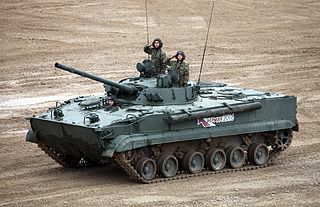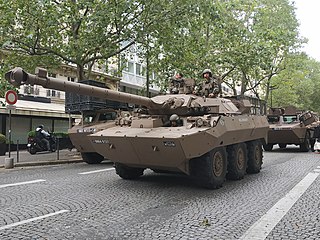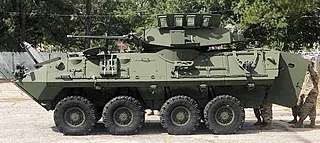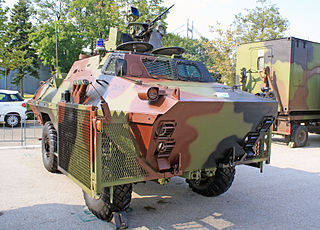
An armoured fighting vehicle or armored fighting vehicle (AFV) is an armed combat vehicle protected by armour, generally combining operational mobility with offensive and defensive capabilities. AFVs can be wheeled or tracked. Examples of AFVs are tanks, armoured cars, assault guns, self-propelled artilleries, infantry fighting vehicles (IFV), and armoured personnel carriers (APC).

The BMP-3 is a Soviet and Russian infantry fighting vehicle, successor to the BMP-1 and BMP-2. The abbreviation BMP stands for Boevaya Mashina Pekhoty.

The Combat Vehicle Reconnaissance (Tracked) (CVR(T)) is a family of armoured fighting vehicles (AFVs) developed in the 1960s and is in service with the British Army and others throughout the world. They are small, highly mobile, air-transportable armoured vehicles, originally designed to replace the Alvis Saladin armoured car.

The FV101 Scorpion is a British armoured reconnaissance vehicle and light tank. It was the lead vehicle and the fire support type in the Combat Vehicle Reconnaissance (Tracked), CVR(T), family of seven armoured vehicles. Manufactured by Alvis, it was introduced into service with the British Army in 1973 and was withdrawn in 1994. More than 3,000 were produced and used as a reconnaissance vehicle or a light tank.

The FV107 Scimitar is an armoured tracked military reconnaissance vehicle formerly used by the British Army, until it was retired from active service in April 2023. It was manufactured by Alvis in Coventry. It is very similar to the FV101 Scorpion, but mounts a high-velocity 30 mm L21 RARDEN cannon instead of a low-velocity 76 mm gun. It was issued to Royal Armoured Corps armoured regiments in the reconnaissance role. Each regiment originally had a close reconnaissance squadron of five troops, each containing eight FV107 Scimitars. Each Main Battle Tank Regiment also employed eight Scimitars in the close reconnaissance role.

The BRDM-2 is an amphibious armoured scout car designed and developed in the Soviet Union. It was also known under the designations BTR-40PB, BTR-40P-2 and GAZ 41-08. This vehicle, like many other Soviet designs, has been exported extensively and is in use in at least 38 countries. It was intended to replace the older BRDM-1, and has improved amphibious capabilities and better armament compared to its predecessor. The BRDM-2 production continues in Poland as of 2022.

The Ferret armoured car, also commonly called the Ferret scout car, is a British armoured fighting vehicle designed and built for reconnaissance purposes. The Ferret was produced between 1952 and 1971 by the UK company Daimler. It was widely used by regiments in the British Army, as well as the RAF Regiment and Commonwealth countries throughout the period.

The M8 light armored car is a 6×6 armored car produced by the Ford Motor Company during World War II. It was used from 1943 by United States and British forces in Europe and the Pacific until the end of the war. The vehicle was widely exported and as of 2024 still remained in service with some countries.

The Alvis Stormer is a military armoured vehicle manufactured by the British company Alvis Vickers, now BAE Systems Land & Armaments.

The AMX-10 RC is a French armoured fighting vehicle manufactured by Nexter Systems for armoured reconnaissance purposes. Equipping French cavalry units since 1981, over 240 remained in service with the French Army in 2021. 108 units were sold to Morocco and 12 to Qatar. "RC" stands for "Roues-Canon", meaning "wheeled gun". English language newspapers have often incorrectly referred to it as a light tank, a mistranslation of the French term "char", which refers to a wider category of armoured fighting vehicles than the English word "tank".

The LAV-25 is a member of the LAV II family. It is an eight-wheeled amphibious armored reconnaissance vehicle built by General Dynamics Land Systems and used by the United States Marine Corps and the United States Army.

The ASCOD armoured fighting vehicle family is the product of a cooperation agreement between Austrian Steyr-Daimler-Puch AG and Spanish General Dynamics Santa Bárbara Sistemas. Both companies are now divisions of a unit of General Dynamics. The ASCOD family includes the LT 105 light tank equipped with a 105 mm gun, a surface-to-air missile launcher, an anti-tank guided missile launcher, mortar carrier, R&R vehicle, command-and-control vehicle, ambulance, artillery observer, and the AIFV model.

The FV721 Fox Combat Vehicle Reconnaissance (Wheeled) (CVR(W)) was a 4 × 4 armoured car manufactured by ROF Leeds, deployed by the British Army as a replacement for the Ferret scout car and the Saladin armoured car. The Fox was introduced into service with B Squadron, 1st Royal Tank Regiment (Aliwal Barracks, Tidworth) in 1975 and withdrawn from service 1993–94.

The L21A1 RARDEN is a British 30 mm autocannon used as a combat vehicle weapon. The Royal Armament Research and Development Establishment (RARDE) and the Royal Small Arms Factory (RSAF), were part of the Ministry of Defence, at the time.
A huge number of M113 armored personnel carrier variants have been created, ranging from infantry carriers to nuclear missile carriers. The M113 armored personnel carrier has become one of the most prolific armored vehicles of the second half of the 20th century, and continues to serve with armies around the world in many roles.

The BOV, is an all-wheel drive armoured vehicle manufactured in the former Yugoslavia and today in Serbia. The second generation BOV is currently in development.

The Type 85 is a tracked armoured fighting vehicle produced by Chinese company Norinco. It is an improved version of the Type 63 armoured personnel carrier. The vehicle is bigger, has additional firing ports and periscopes, a longer chassis with an additional road wheel on each side, and is equipped with an NBC protection system.

A reconnaissance vehicle, also known as a scout vehicle, is a military vehicle used for forward reconnaissance. Both tracked and wheeled reconnaissance vehicles are in service. In some nations, light tanks such as the M551 Sheridan and AMX-13 have also been used by scout platoons. Their armament ranges from a medium machine gun to a large cannon. Modern examples are often fitted with ATGMs and a wide range of sensors.

The K808/806 White Tiger wheeled armored personnel carrier (APC) is family of 8x8 and 6x6 armored vehicles. Developed by Hyundai Rotem as a private venture in 2012, the Korean Army declared a plan to acquire 600 6×6 and 8×8 wheeled APCs in order to help build rapid response forces molded after U.S. Stryker combat brigades, according to the Defense Acquisition Program Administration (DAPA).


















